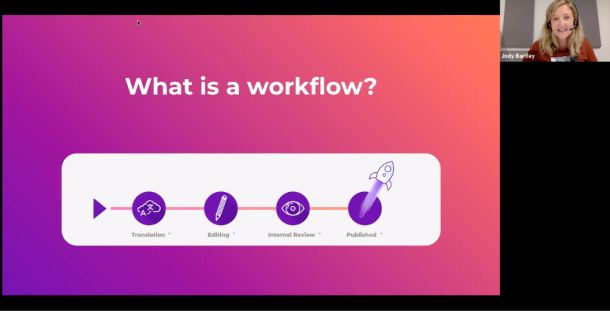Growing businesses face several localization challenges during global expansion. They must adjust their content to different cultural expectations and adhere to international regulations for business documents, all while balancing a strict budget. They need an experienced leader with a structured management system to overcome these challenges.
Fortunately, localization management professionals can help. Instead of treating localization as a small part of your marketing, product, or development team’s workload, companies who want to prioritize efficient global growth can employ a localization expert to lead the adaptation of their content, software, and products for international audiences. The localization project manager oversees a company’s entire translation process, coordinating translation projects for product managers, designers, developers, and marketers.
This article covers what localization project management is, the responsibilities of the role, and how businesses benefit when a dedicated localization expert leads the way.
What is a localization project manager?
A localization project manager supervises the adaptation of a company’s content, software, or services for different markets. This manager role coordinates project management workflows, organizes teams, and keeps projects on track and within budget.
Localization requires diverse expertise, from content creation to design and development. The localization project manager must work across departments to keep operations running smoothly. They perform the following tasks to produce localized content and business communications:
- Planning and overseeing the entire localization process
- Coordinating interdepartmental teams and initiatives
- Managing the budget, timeline, and vendor relationships
- Tracking progress and dynamically adjusting workflows
- Identifying and solving localization challenges as they arise
Localization is an ongoing effort—not a one-time process. Project management plays a continuous role in international market expansion, maintaining efficiency and quality.
5 ways localization project management enhances a global business
International organizations enjoy the following benefits when they dedicate experienced localization professionals to manage translation in support of global growth:
Smooth entry into international markets
Some markets are more competitive than others, and they all require unique cultural considerations. Thoughtful market research can save time and resources. Localization managers are skilled in handling global expansion and overcoming challenges, such as:
- Regulatory compliance: Each country has distinct laws and regulations governing business practices. A localization project manager coordinates with legal experts to ensure compliance.
- Scope creep: Without clearly defined goals, projects can expand beyond their original intentions, leading to disruptions and delays. Localization project managers establish clear tasks to prevent scope creep.
- Market research: Companies must understand consumer behavior and cultural nuances to break into a new region. Localization project managers gather the necessary data to guide a company’s international marketing strategy.
Structured approach to localization
Managing content in multiple languages becomes more complicated with each new market entry. A localization project manager implements systems to scale localization efforts across websites, software, and marketing materials. These often incorporate software solutions that simplify coordination and reduce manual work.
Most localization professionals will be familiar with the latest localization technology, enabling them to implement software that makes localization efficient and scalable. For example, Smartling’s translation management system (TMS) provides localization project managers with one centralized platform to manage translations at a high volume without sacrificing accuracy or efficiency.
Consistent multilingual content
Translations can get messy without a central authority to implement quality standards. Companies risk outdated info, inconsistent brand messaging, and awkward phrasing. Expansion into international markets requires a content management system capable of handling multiple languages across various platforms.
With the support of translation technology like Linguistic Quality Assurance tools, a localization project manager can ensure localized content meets quality standards across regional translations and aligns with updates to brand messaging and voice.
Efficient localization teams and streamlined workflows
Localization isn’t a solo effort. Linguists, developers, designers, and marketers all work on different pieces of the puzzle. Someone must connect the dots to avoid miscommunications and delays. A localization project manager keeps everything running smoothly, ensuring each team member knows what needs to be done and when.
Carefully managed budgets and resources
Localization comes with costs. Without proper oversight, those costs can spiral fast. A localization project manager keeps spending in check by managing the budget, tracking expenses, and carefully allocating resources. With diligent monitoring and analysis, they know exactly where to invest—whether hiring translators, using machine translation, or adjusting workflows to save time.
A localization project manager’s job description
Project management is a demanding job, regardless of the initiative, but localization brings additional challenges. A localization project manager must fulfill the following duties in their role:
Oversee end-to-end localization workflows
A localization program manager plans and oversees the entire localization process, from the first request to final delivery. They create timelines, assign tasks, track progress, and monitor results after launch. They step in to fix issues as they arise and adjust workflows as needed. Once the project is complete, they look for ways to improve their process for future initiatives.
Coordinate stakeholders, translators, freelancers, and internal teams
A localization project manager maintains team alignment and smooth operations. They communicate expectations and facilitate collaboration between stakeholders, translators, freelancers, and internal teams, keeping all parties aligned and projects on track. The localization project manager should also track deadlines and adjust schedules when projects fall behind, communicating with stakeholders when necessary.
Implement and optimize localization strategies that advance business goals
A localization project manager plays a key role in shaping their company’s localization strategy. This looks like deciding which translation methods to use for the variety of content types they need to translate. Different translation methods can help companies achieve different goals; AI-powered translation workflows can reduce costs and support high-volume translation at scale, while professional transcreation services ensure brand messaging resonates across diverse markets. By understanding the strengths of each approach, localization project managers can optimize workflows to balance quality, speed, and cost—and ultimately help their companies achieve global success.
Assess workflow risks and maintain translation quality
A localization project manager identifies risks that could delay projects or impact quality. They watch for issues like questions from translators or text expansion that disrupts layouts. If bottlenecks slow progress, they adjust workflows to keep multilingual content moving.
Integrate AI and translation tools for efficiency and scalability
A localization project manager seeks out technology like AI tools to improve the translation process and handle growing workloads. They assess localization software, champion the right solution for their business, and become their company’s expert in this technology, helping lead software implementation, team training, and performance tracking.
Develop glossaries, style guides, and localization guidelines
A localization project manager should manage the creation and maintenance of linguistic resources that uphold translation consistency across various markets. They build glossaries with approved terminology, style guides that define tone and voice, and tailored localization guidelines for each region. These documents keep translators aligned with a company’s brand voice and messaging, reducing errors and miscommunications.
Simplify localization with Smartling
Managing localization at scale can feel overwhelming, but Smartling’s translation management system is built to streamline the process. With Smartling’s TMS and localization services, project managers can handle large-scale localization without getting bogged down by tedious tasks.
Our solution automates labor-intensive aspects of translation workflows, helping localization project managers reduce manual work, stay on schedule, and control costs. The platform provides glossaries, style guides, and quality checks, guaranteeing your translations stay accurate and on-brand across all markets.
Ready to improve your localization process? Download our eBook, “How to Unleash Success in Your Localization Career,” for expert tips and best practices from global professionals. You’ll gain actionable insights to streamline workflows and take your localization strategy to the next level.
Growing businesses face several localization challenges during global expansion. They must adjust their content to different cultural expectations and adhere to international regulations for business documents, all while balancing a strict budget. They need an experienced leader with a structured management system to overcome these challenges.
Fortunately, localization management professionals can help. Instead of treating localization as a small part of your marketing, product, or development team’s workload, companies who want to prioritize efficient global growth can employ a localization expert to lead the adaptation of their content, software, and products for international audiences. The localization project manager oversees a company’s entire translation process, coordinating translation projects for product managers, designers, developers, and marketers.
This article covers what localization project management is, the responsibilities of the role, and how businesses benefit when a dedicated localization expert leads the way.
What is a localization project manager?
A localization project manager supervises the adaptation of a company’s content, software, or services for different markets. This manager role coordinates project management workflows, organizes teams, and keeps projects on track and within budget.
Localization requires diverse expertise, from content creation to design and development. The localization project manager must work across departments to keep operations running smoothly. They perform the following tasks to produce localized content and business communications:
- Planning and overseeing the entire localization process
- Coordinating interdepartmental teams and initiatives
- Managing the budget, timeline, and vendor relationships
- Tracking progress and dynamically adjusting workflows
- Identifying and solving localization challenges as they arise
Localization is an ongoing effort—not a one-time process. Project management plays a continuous role in international market expansion, maintaining efficiency and quality.
5 ways localization project management enhances a global business
International organizations enjoy the following benefits when they dedicate experienced localization professionals to manage translation in support of global growth:
Smooth entry into international markets
Some markets are more competitive than others, and they all require unique cultural considerations. Thoughtful market research can save time and resources. Localization managers are skilled in handling global expansion and overcoming challenges, such as:
- Regulatory compliance: Each country has distinct laws and regulations governing business practices. A localization project manager coordinates with legal experts to ensure compliance.
- Scope creep: Without clearly defined goals, projects can expand beyond their original intentions, leading to disruptions and delays. Localization project managers establish clear tasks to prevent scope creep.
- Market research: Companies must understand consumer behavior and cultural nuances to break into a new region. Localization project managers gather the necessary data to guide a company’s international marketing strategy.
Structured approach to localization
Managing content in multiple languages becomes more complicated with each new market entry. A localization project manager implements systems to scale localization efforts across websites, software, and marketing materials. These often incorporate software solutions that simplify coordination and reduce manual work.
Most localization professionals will be familiar with the latest localization technology, enabling them to implement software that makes localization efficient and scalable. For example, Smartling’s translation management system (TMS) provides localization project managers with one centralized platform to manage translations at a high volume without sacrificing accuracy or efficiency.
Consistent multilingual content
Translations can get messy without a central authority to implement quality standards. Companies risk outdated info, inconsistent brand messaging, and awkward phrasing. Expansion into international markets requires a content management system capable of handling multiple languages across various platforms.
With the support of translation technology like Linguistic Quality Assurance tools, a localization project manager can ensure localized content meets quality standards across regional translations and aligns with updates to brand messaging and voice.
Efficient localization teams and streamlined workflows
Localization isn’t a solo effort. Linguists, developers, designers, and marketers all work on different pieces of the puzzle. Someone must connect the dots to avoid miscommunications and delays. A localization project manager keeps everything running smoothly, ensuring each team member knows what needs to be done and when.
Carefully managed budgets and resources
Localization comes with costs. Without proper oversight, those costs can spiral fast. A localization project manager keeps spending in check by managing the budget, tracking expenses, and carefully allocating resources. With diligent monitoring and analysis, they know exactly where to invest—whether hiring translators, using machine translation, or adjusting workflows to save time.
A localization project manager’s job description
Project management is a demanding job, regardless of the initiative, but localization brings additional challenges. A localization project manager must fulfill the following duties in their role:
Oversee end-to-end localization workflows
A localization program manager plans and oversees the entire localization process, from the first request to final delivery. They create timelines, assign tasks, track progress, and monitor results after launch. They step in to fix issues as they arise and adjust workflows as needed. Once the project is complete, they look for ways to improve their process for future initiatives.
Coordinate stakeholders, translators, freelancers, and internal teams
A localization project manager maintains team alignment and smooth operations. They communicate expectations and facilitate collaboration between stakeholders, translators, freelancers, and internal teams, keeping all parties aligned and projects on track. The localization project manager should also track deadlines and adjust schedules when projects fall behind, communicating with stakeholders when necessary.
Implement and optimize localization strategies that advance business goals
A localization project manager plays a key role in shaping their company’s localization strategy. This looks like deciding which translation methods to use for the variety of content types they need to translate. Different translation methods can help companies achieve different goals; AI-powered translation workflows can reduce costs and support high-volume translation at scale, while professional transcreation services ensure brand messaging resonates across diverse markets. By understanding the strengths of each approach, localization project managers can optimize workflows to balance quality, speed, and cost—and ultimately help their companies achieve global success.
Assess workflow risks and maintain translation quality
A localization project manager identifies risks that could delay projects or impact quality. They watch for issues like questions from translators or text expansion that disrupts layouts. If bottlenecks slow progress, they adjust workflows to keep multilingual content moving.
Integrate AI and translation tools for efficiency and scalability
A localization project manager seeks out technology like AI tools to improve the translation process and handle growing workloads. They assess localization software, champion the right solution for their business, and become their company’s expert in this technology, helping lead software implementation, team training, and performance tracking.
Develop glossaries, style guides, and localization guidelines
A localization project manager should manage the creation and maintenance of linguistic resources that uphold translation consistency across various markets. They build glossaries with approved terminology, style guides that define tone and voice, and tailored localization guidelines for each region. These documents keep translators aligned with a company’s brand voice and messaging, reducing errors and miscommunications.
Simplify localization with Smartling
Managing localization at scale can feel overwhelming, but Smartling’s translation management system is built to streamline the process. With Smartling’s TMS and localization services, project managers can handle large-scale localization without getting bogged down by tedious tasks.
Our solution automates labor-intensive aspects of translation workflows, helping localization project managers reduce manual work, stay on schedule, and control costs. The platform provides glossaries, style guides, and quality checks, guaranteeing your translations stay accurate and on-brand across all markets.
Ready to improve your localization process? Download our eBook, “How to Unleash Success in Your Localization Career,” for expert tips and best practices from global professionals. You’ll gain actionable insights to streamline workflows and take your localization strategy to the next level.
Tags: Optimize Blog Professional Services
.jpg)





